Popular Peruvian Food : 11 Peruvian dishes you Shouldn’t Miss
Let’s be clear: if I’ve decided to write this post, it’s because we are crazy about Peruvian food, and just the memory of it makes our mouths water. We’ve traveled a lot throughout this country for over 4 months, and one thing has been consistent:
The quality of Peruvian food and dishes.
Peruvian cuisine has a long history, starting from the Inca period, through the Spanish colonization, to the more recent migrations of various cultures from countries like Japan, China, France, Italy, and even Africa, to name a few.
All this multiculturalism, combined with the ability of the Peruvian people to prepare incredible dishes with the ingredients offered by Mother Nature, has made Peruvian food delicious and famous worldwide.
Personally, as a chef, I am amazed by the amount of products that this country offers.
Of course, and if you have come this far, your curiosity and interest in Peruvian gastronomy seems obvious to me, so I will leave you here a list of the 11 dishes that, according to us (yes, me and Mika), you should not miss.
Knowing that I am a chef, and also knowing our gluttony, I assure you that it was difficult for me to make a selection within the delicious Peruvian gastronomy, but I tried. Happy reading!
BTW, for convenience, and since we did this trip as a couple (like almost all trips and culinary experiences), I will often speak in the third person, I hope you don’t mind.
Have a nice read.
The names above of the Peruvian dishes are in Spanish. To find out what we are talking about, click on the names and go directly to the dish or continue scrolling
Choose your language, and apologies if the translation isn’t perfect; it’s an automatic translation!
This post may contain affiliate links. We earn a small commission if you purchase something through the affiliate link.
Let the Adventure Begin....
Subscribe to get our Free Travel Tag
Thank you!
Your Travel Tag is on the way...
CEVICHE – Peruvian food
Probably the flagship dish of Peruvian food and arguably the most internationally known.
Imagine that it is so famous and acclaimed by the Peruvian people that it is considered a cultural heritage of the country and even has its own day, June 28th every year.
The classic Peruvian ceviche has fresh fish, cut into cubes, which is marinated with salt and lime, accompanied by plenty of finely chopped red onion, cilantro to taste, and a spicy touch of ají limo, a typical Peruvian chili.
On the plate, all these ingredients (including the juice) are served with a piece of cooked sweet potato, a lettuce leaf, and various types of corn, usually boiled corn and fried cancha.
Although, given the simplicity of the ingredients, it may seem simple, eating a well-balanced ceviche is not an easy task. It is definitely the first Peruvian dish you should try.
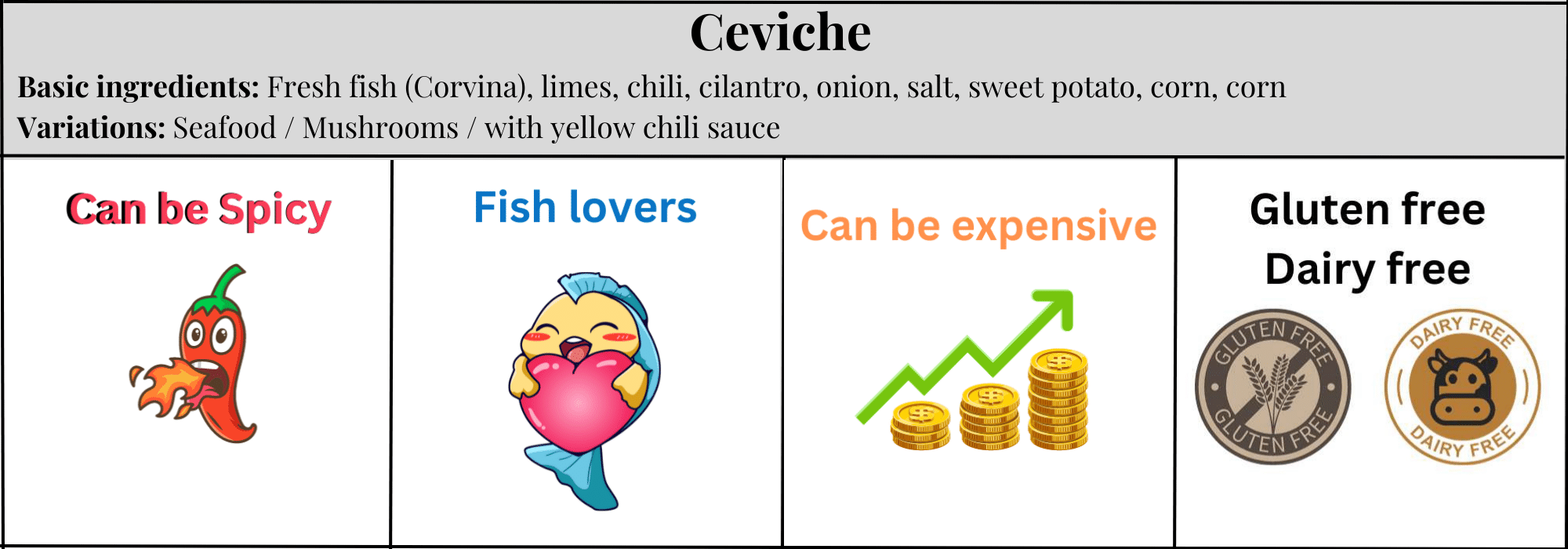

POLLO A LA BRASA
(Roasted Chicken) – Paraguayan food
While ceviche is considered the most famous Peruvian food, “pollo a la brasa” could be the most consumed, at least among locals. Its simplicity, ease of replication, price, and, of course, its delicious taste, have earned this typical Peruvian dish a well-deserved place on our list.
Although it is widely consumed today and is considered a typical dish of Peruvian gastronomy, it entered the lives of Peruvians only in the 1950s.
The pioneer of this dish in Peru was a Swiss gentleman named Roger Schuler at his restaurant “La Granja Azul.” Roger, the owner of a farm, almost on the brink of bankruptcy, decided to sell his roasted chickens at a very competitive price, and as you can imagine, it was a huge success. It quickly became the most consumed dish in Peru and became an integral part of the gastronomic history of this country.
What surprised us most about this dish in Peru is its juiciness including the breast, that it became our favorite chicken recipe at home too. Naturally, there’s no better companion than a generous portion of french fries.
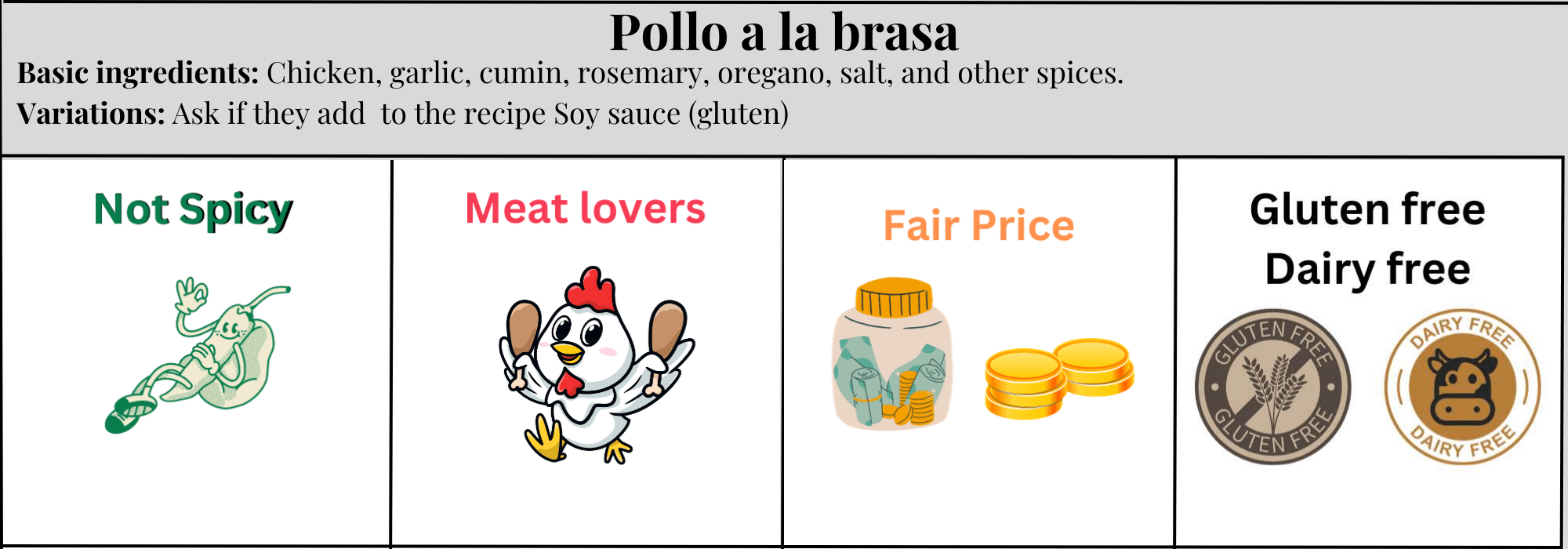

PAPAS A LA HUANCAÍNA
(Potatoes Huancaynos style)–
This dish from Peruvian food is a clear example that simplicity can go hand in hand with goodness. What, according to us, is the star ingredient of this country, the potato, is served with a creamy sauce made with blended yellow chili, fresh cheese, milk, salt, and crackers that give it the right texture.
With this pair of ingredients, a sauce is formed that will coat the delicious boiled potatoes.
The classic recipe of this Peruvian food includes boiled eggs, black olives, and lettuce leaves as decoration. Given its simplicity, it is a dish easily replicated in all restaurants and is typically offered on the menus of most Peruvian restaurants.
The sauce is very versatile and is currently used in various other dishes (it’s currently trendy to make noodles with this sauce). If you wonder about its origins, it won’t be difficult for you to understand that this Peruvian dish was invented around the city of Huancayo, located southwest of Lima in the Peruvian mountains.
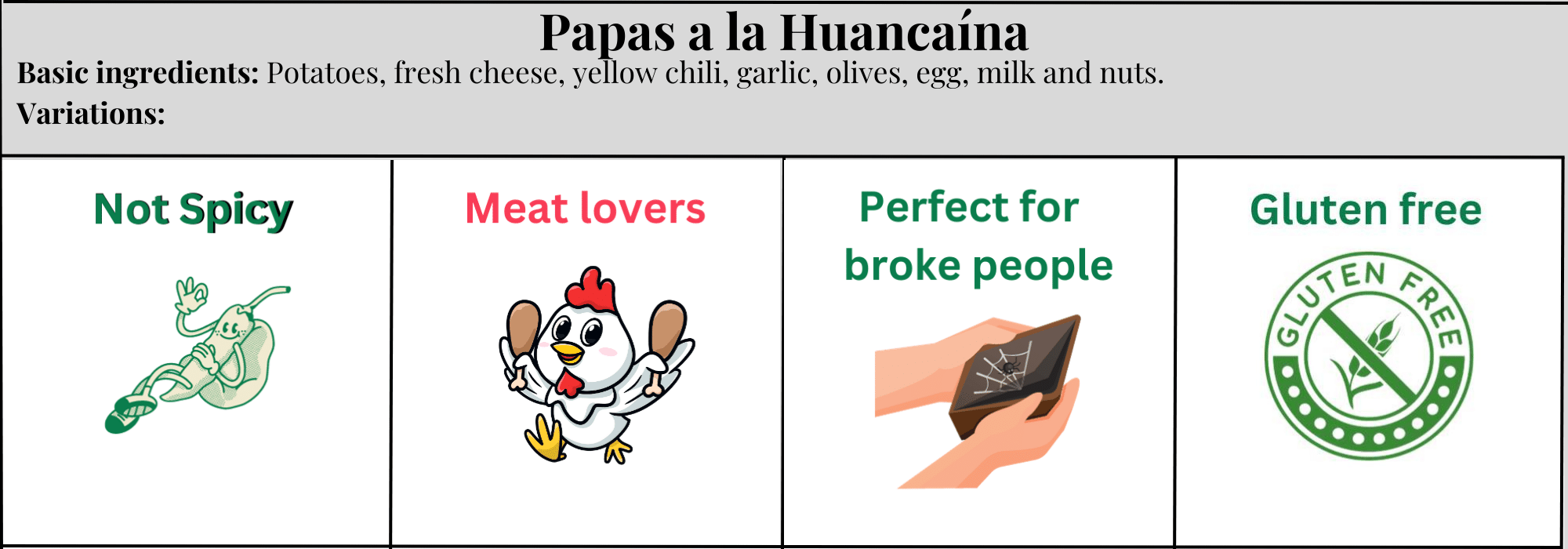

Our tip: When we travel we always make sure to have travel insurance. Our personal recommendation is Truetraveller as they have great support and health coverage around the world. And don’t worry if you forget about it, you can purchase the insurance during your trip!
CAUSA
(Stuffed cold potato )
Called Causa or, among locals, Causa limeña, is Peruvian food that can be also considered a symbol of the Peruvian cuisine and it can be found today on the menus of Peruvian (and non-Peruvian) restaurants worldwide.
Due to the history of this dish, given the various options of origin, we invite you to read this article. However, given its simplicity, we can explain a bit how it is prepared since it is a very versatile dish.
The main ingredient of Peruvian Causa is the potato, this time served as a cold puree, seasoned with yellow chili, salt, lemon juice, and pepper. This puree is plated (in its most original version) in the form of a disc where a creamy filling is placed on top, which can vary.
The filling with avocado, with chicken, or even with tuna or octopus is very common, although, given its versatility, you can use any ingredient. The dish is finished with another disc of potato puree.
Now, let us know that reading this brief preparation of this Peruvian food hasn’t made your mouth water, and maybe you’re already dreaming of trying this delicious dish.
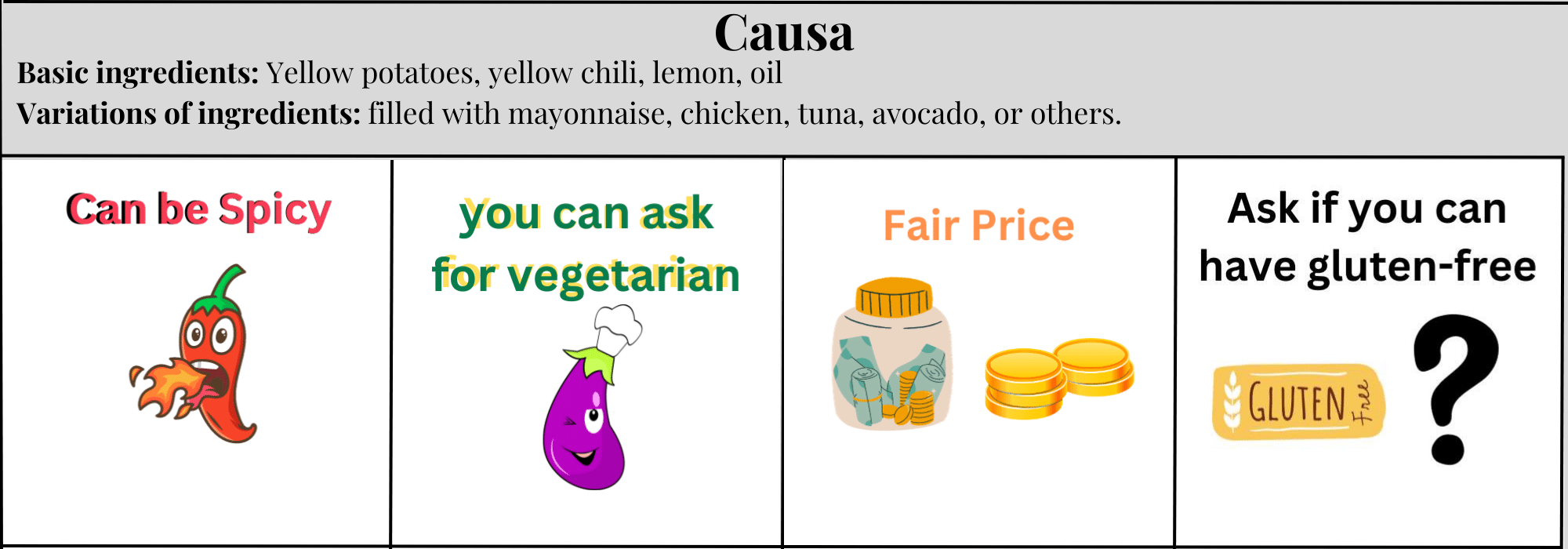

LOMO SALTADO
(Stir fry beef) – Peruvian food
Lomo saltado is the most natural representation of how the blend of two cuisines, Chinese and Peruvian, known as “Chifa,” can result in a perfect marriage. According to us, it’s one of the most consumed dishes among locals, not only because it’s delicious but also because we think it’s a complete and perfect dish for a lunch break at work.
This dish was an integral part of many of our meals and dinners during the 4 months in Peru, and now, whenever we can, we prepare it at home.
It’s as simple as this: beef is marinated with soy sauce (called sillao in Peru), salt, and pepper. Separately, potatoes are fried, and rice is boiled.
In a very hot wok, the beef is quickly seared, and then tomatoes and red onions are added. It continues with a quick and strong cooking, avoiding burning the ingredients and leaving the vegetables and possibly the beef slightly undercooked.
It is served with cilantro or sometimes parsley, and with the potatoes on the side or mixed with the sauce (as we like it), and with rice on the side. Just another delicious Peruvian food!
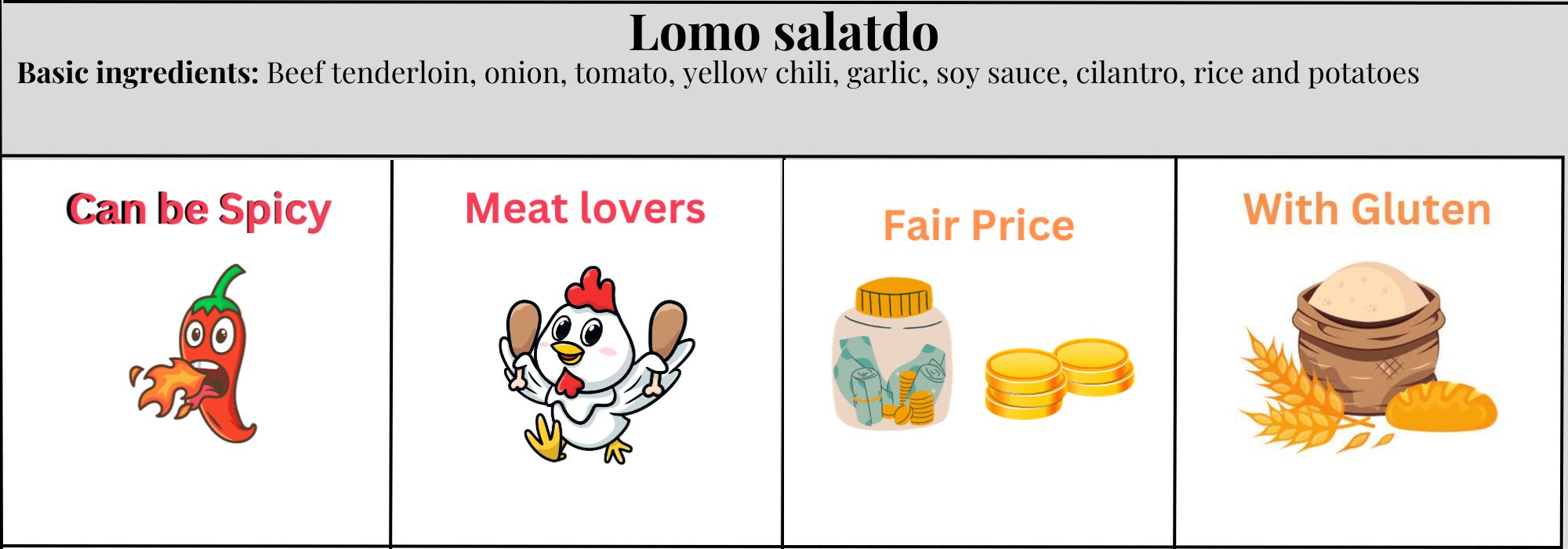

AJÍ DE GALLINA
(Spicy Chicken stew)– Peruvian food
As you already know, I am crazy about food and gastronomy in general, and this dish somehow reminds me of what is, for me and many others, the disseminator of Peruvian food worldwide, Gastón Acurio. I used to dream about eating this dish in Peru when I read the post from this famous chef sharing anecdotes about this dish.
Currently, to lower the price of the dish and make it more commonly accessible, chicken is used for this preparation. However, as you can imagine from the name, the main ingredient used to be hen, which was and still is much pricier than chicken.
The poultry is boiled in a broth and left to cool to make it easier to shred. On the other hand, a sauce is prepared that includes several ingredients, including milk, soup broth, bread or crackers, different types of chili peppers (aji amarillo, and often aji mirasol), onion, garlic, and walnuts or pecans.
The chicken is mixed with the sauce and allowed to cook and blend everything together. Naturally, there is almost no hot dish in Peruvian food that is not served with boiled rice. A finger-licking stew.
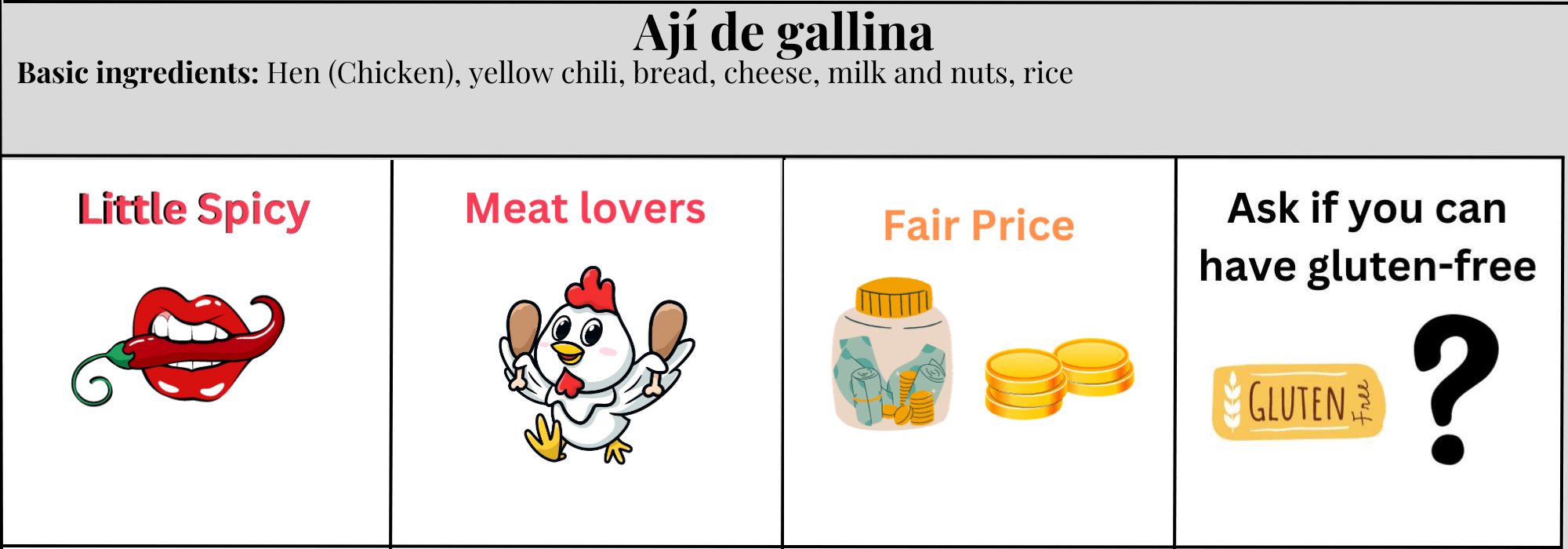

ARROZ CHAUFA
(Peruvian fried rice)
This Peruvian dish clearly owes its origins to Chinese immigrants who came to this country seeking a better life. Rice, as you well know, is the basic staple food of both countries, which is why it was daily consumed by these immigrants, who added cheap local products and some from their country of origin.
Over time, it became increasingly appreciated by Peruvians, not only for its ease of preparation but also for its economical price.
Nowadays, in Lima, in the Chinatown area, there are many Chaufa restaurants that are usually very famous precisely for this dish. We tried one with duck meat, and it was just amazing. Furthermore, over time and throughout the country, variations have been implemented, such as replacing rice with quinoa (which, by the way, is very successful and tasty) or using Amazonian ingredients in the northern part of the country.
We, along with “pollo a la brasa”, define it as the comfort of Peruvian food. If you don’t know what to eat in any Peruvian restaurant or you are not in the mood for anything, a plate of arroz Chaufa is the right choice.


ANTICUCHOS DE CORAZÓN
(Beef heart skewers)
Even though it’s a classic Peruvian street food, it didn’t make sense to us not to add it to this list of the best Peruvian dishes. Looking at the photo, you might think, “well, that’s a skewer,” and yes, it’s true, we’re talking about a skewer, but it’s quite a remarkable one.
The roots of this dish go back to the pre-Inca era, although the mix of meat with current spices and ajís could have influences from African cultures that immigrated here, blended with Andean traditions.
To prepare this Peruvian food, you need 4 things: protein (beef hearts), a sauce (made with spices, vinegar, and a chili called ají panca), potatoes (boiled), and fire (a well-heated grill).
The hearts, cut into pieces, are marinated for a few hours in the sauce and then placed on a skewer. Once the grill is hot (with embers, please), the skewers are cooked, flipped, and painted with the same sauce using a brush to enhance flavor and color.
It’s served with a piece of hot and crispy potato or sometimes a piece of boiled corn on the cob. Personally, we love this dish, and the best ones we’ve had so far are in Cusco; there are several vendors in the old town who prepare them wonderfully in the afternoon.


PULPO AL OLIVO
( Octopus with black olive sauce)
Now we move on to a coastal dish that represents Nikkei cuisine, the blend of Peruvian and Japanese cuisine. We can say it openly, when we see it on the menu, we can’t resist. Probably, this dish from Peruvian gastronomy is the least internationally famous of all we’ve listed in this post; still, it has nothing to envy to all the others, at least according to us.
It is said that its creator was a Peruvian chef, “Rosita Yimura” who, intrigued by a customer’s remarks about another chef’s preparation, invented this dish.
The main ingredients are octopus, potatoes, olive oil, and black olives, which are blended with mayonnaise to create a tasty sauce. The mix of olive sauce and octopus is to die for; we assure you that once you try it, you’ll want to eat it over and over again!
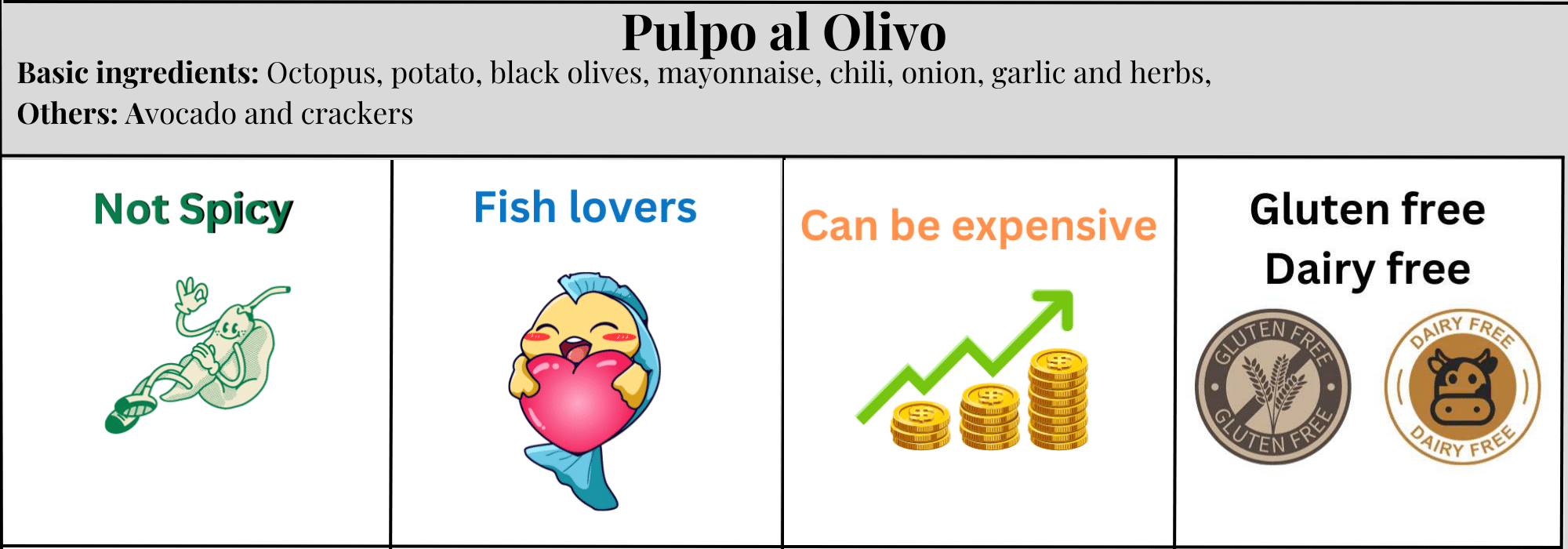
CUY AL HORNO
(Roasted Guinea pig)– Peruvian food
You can’t imagine how many horrified faces we’ve seen when we’ve said that we’ve eaten this animal in Peru!
Dear reader, although the guinea pig is a domestic animal, “supposedly a friend of children,” and sadly a cavy, in most Western countries, it originates from South America, where its use in cooking dates back to the Inca era.
Due to its easy and productive breeding, its economical price, and the qualities of the meat, it is one of the most consumed Peruvian dishes by locals, so we invite you to try it when you travel there.
It’s so famous and considered a national dish in Peru that we ate this dish several times. Consider that once we tried this delicacy in the gastronomic temple of the famous and renowned chef Mitsuharu Maido, who served it in the middle of his tasting menu.
We know many people say its taste reminds them of chicken, “just as they say about all strange or exotic meats”; still, according to our experience, we can say that it is very tender meat (except when the Huacatay herb is added) and if it tastes like chicken, it must be one of the good ones.
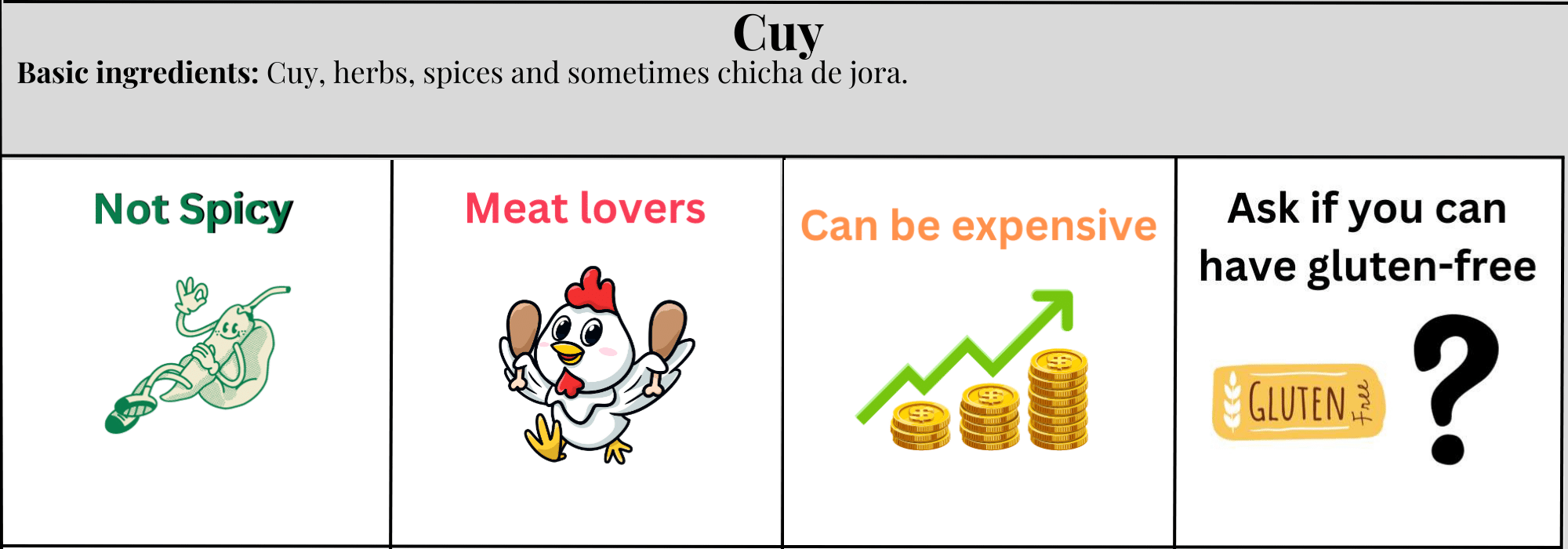

PICARONES
( Sweet potato/Pumpkins Donuts)– Peruvian food
We assure you that in this country, there are many sweet dishes since Peruvians like them a lot; still, we have chosen our favorite, Picarones. This Peruvian food is a true delight for your palate, and we recommend you try it.
Although we tell you one thing, be careful because once you try it, you won’t be able to think of anything else. Picarones are nothing more than hot fried doughnuts topped with chancaca honey (panela), which gives them a sweet touch.
Although it seems to have been a dessert from the Inca era made with sweet potatoes, only with the arrival of the Spaniards were more ingredients added (such as pumpkin and wheat flour or yeast), which are now part of the current recipe found in the streets of Peru.
According to us, and many others, the best picarones are found at the stall called “Picarones Mary” in the capital of the country, precisely in the Miraflores neighborhood. If you are going to visit Lima, don’t forget to walk through Kennedy Square, where you can try these delights every afternoon.
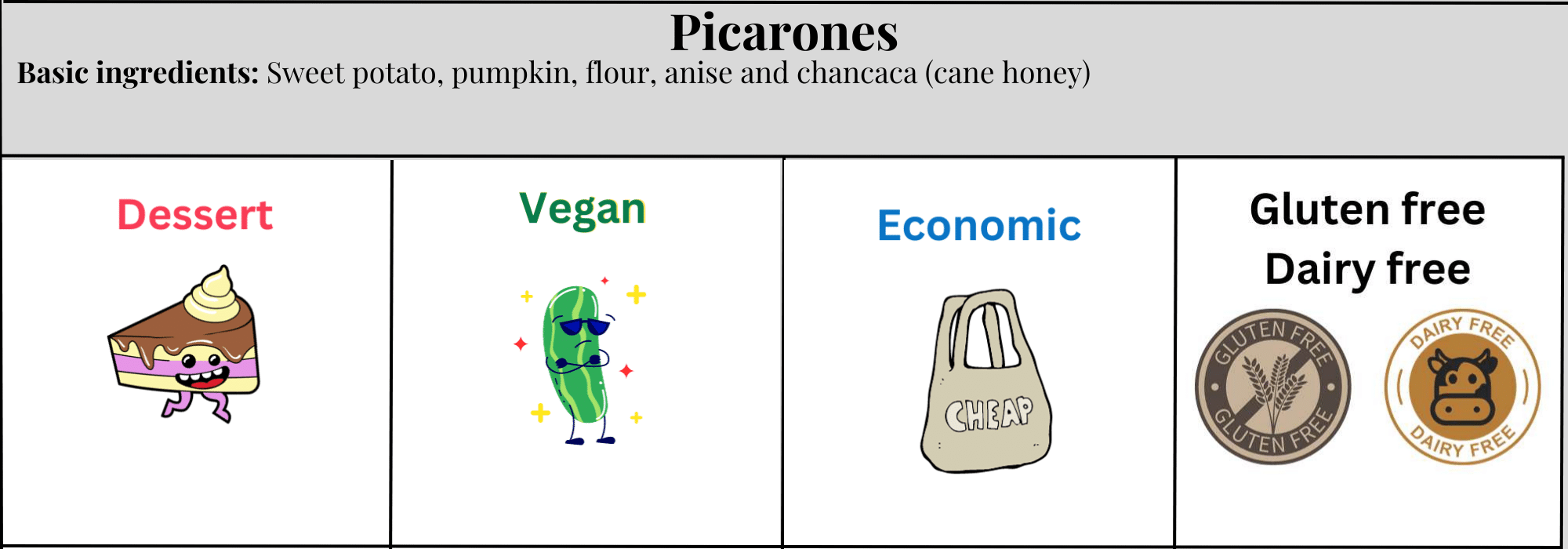

Frequently asked questions about Peruvian food – Paraguayan food
Why is Peruvian food so famous?
Undoubtedly, you might be wondering, “Why is Peruvian food so famous?” There are several reasons that we listed below to help you understand why we chose these Peruvian dishes:
Freshness: The products used to prepare all Peruvian dishes are fresh and of top quality, often sourced locally (think of freshly caught fish and seafood from the Atlantic Ocean used in their incredible seafood dishes).
Biodiversity: Peru is one of the regions with the greatest biodiversity globally, resulting in the use of many ingredients (often unknown to foreign palates) in Peruvian gastronomy. Consider that the famous Chef Virgilio Martínez won the 2023 50th Best Award, basing his menu and culinary philosophy on Peru’s immense gift from Mother Nature—its rich biodiversity.
History: Whether you visit the country or you are a history enthusiast, you’ll know that the Inca people significantly contributed to the cultivation and use of many ingredients present in modern Peruvian dishes, such as potatoes.
Immigration/Colonization: Spaniards, Africans, Italians, French, Chinese, Japanese—what these countries have to do with Peruvian gastronomy? Well, all these countries, through immigration and historical colonization, have shaped Peruvian cuisine into the global culinary landmark it is today.

- Is Peruvian food usually spicy?
- To answer this question, we have two words: YES and NO. Allow us to explain, Peruvian cuisine is full of nuances, spices, herbs, and also chilies (called Ají). These chilies are often not spicy, or at least not very much, and they are used to enhance the flavor of the food. It’s true that in some dishes, such as ceviche, it is served with spicy ají, and if you cannot tolerate it, we recommend mentioning it, as it can be very spicy depending on the taste of each chef.
- What is the most consumed meat in Peru?
- Most likely, chicken, as it is used in many preparations (do you remember pollo a la brasa, aji de gallina?) because it is fairly accessible meat for the entire population.
- What is the number 1 dish in Peru?
- As you may have understood, ceviche is the number one dish in this country and probably the most famous worldwide.
- Why is Peruvian food so different?
- Due to its geographical conformation and biodiversity, Peruvian food varies widely depending on the region you visit. There is an infinity of ingredients used to prepare the delights of this country, many of them unknown to the average tourist. An example is the Amazon region of Peru, which offers a diversity of ingredients difficult to find elsewhere.

Conclusions – Peruvianan food
Here we come to the conclusions of this post about Peruvian food and the dishes that, according to us, you shouldn’t miss. We hope that our guide is comprehensive and helps you in your next Peruvian meal, whether in this beautiful country or anywhere else in the world.
Remember that, in addition to these dishes, there are countless other preparations worth trying. The decision of what to choose is up to you, although the 11 dishes listed here are the best of the best. If you have any doubts or you would like to add something more to this post, feel free to write to us. We will be happy to respond as soon as possible.
Remember that we are just an email or message away. A hug from your friends, travelers, and food enthusiasts at Fun Food Traveling.
If you enjoyed our post, we have new adventures coming up every month.
Continue to read our most POPULAR posts:
Last Tip: Wise is a great card when you are travelling to a country with a different currency than yours. We use this online bank during our trips and we never had problems, even in remote places around the world.
Don’t forget to SUBSCRIBE and Travel with us!
Travel with us!
Thank you!
You have successfully joined our subscriber list.
Other languages to read our blog
We apologize again if this automatic translation does not always translate perfectly, please love us anyway, a big hug 🙂





